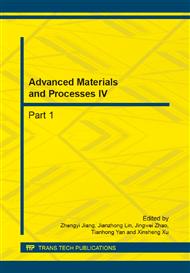[1]
Fadeyev A. B. Finite element method in geomechanics. Moscow: Nedra, 1987. Pp. 1–221. (rus).
Google Scholar
[2]
Brinkgreve R.B.J., Broere W., Waterman D. Plaxis 2D-version 9. Finite Element Codefor Soiland Rock Analyses. User Manual. Rotterdam: Balkema, 2008.
Google Scholar
[3]
Vermeer P.A., Brinkgrive R.B.J. Manual of Plaxis. Rotterdam, (2001).
Google Scholar
[4]
Shanz T., Vermeer P. A., Bonnier P. G. The hardening soil model: Formulation and verification. Beyond 2000 in Computational Geotechnics – 10 years of Plaxis. Pp. 1–16.
DOI: 10.1201/9781315138206-27
Google Scholar
[5]
Slivets K.V. Definition of the internal parameters of Hardening Soil Model. Geotekhnika. 2010. No. 6. Pp. 55–59. (rus).
Google Scholar
[6]
Fadeyev A.B. Parameters of Hardening Soil Model realised in program PLAXIS. Saint-Petersburg: Izd-vo SPbGASU, 2012. Pp. 13–20. (rus).
Google Scholar
[7]
Garkavko A.A. Construction solutions of deep excavation support suystems. Master's thesis. Saint-Petersburg: SPbGPU, 2011. (rus).
Google Scholar
[8]
Paramonov V.N. Experimental verification of the adaptability of some soil models for calculation of retaining walls. Vestnik Tomskogo gosudarstvennogo arkhitkturno-stroitelnogo universiteta. 2008. No. 4. Pp. 139–145. (rus).
Google Scholar
[9]
Slivets K.V. Investigation of retaining walls developed in silty and clayey soils. PhD theis. Saint-Petersburg, 2009. (rus).
Google Scholar
[10]
Ter-Martirosyan A.Z., Mirnyy A. Yu., Sidorov V.V., Sobolev Ye.S. Determination of parameters of Hardening Soil model by the results of laboratory soil testing. Geotechnics. Theory and practice. All-Russian Conference of Young Scientists, researchers and professionals: interuniversity thematic collection of works. Saint-Petersburg: Izd-vo SPbGASU, 2013. Pp. 141–146. (rus).
Google Scholar
[11]
Sherstyanykh K. E. Ground-anchor fencing of excavation support. Master's thesis. Saint-Petersburg: SPbGPU, 2011. 94 p. (rus).
Google Scholar
[12]
Bezgadov M. A., Kaloshina S. V. Selecting a soil model for computational modeling of the influence of deep excavation on existing buildings. Vestnik PNIPU. Urbanistika. 2012. No. 2. Pp. 17–27. (rus).
Google Scholar
[13]
Kolybyn I.V. Experience of emergency accidents during the excavations in urban conditions. Razvitiye gorodov i geotekhnicheskoye stroitelstvo. 2008. No 12. Pp. 30–66. (rus).
Google Scholar
[14]
Chunyuk D. Yu., Yarnykh V.F. Reducing geotechnical risks in construcrion on the example of calculation and design of deep excavations in cramped conditions megacities. Vestnik MGSU. 2009. No 2. Pp. 168–176. (rus).
Google Scholar
[15]
Golubev A. I., Seletskiy A. V. On the selection of soil model for geotechnical calculations. Actual scientific and technical problems of modern geotechnics. Vol. 2. Saint-Petersburg: Izd-vo SPbGASU, 2009. Pp. 6–10. (rus).
Google Scholar
[16]
Strokova L.A. Scientific and methodical principles of computational modeling of deformation soils. Abstract of doctoral thesis. Tomsk, 2011. (rus).
Google Scholar
[17]
Strokova L. A. Determination of parameters for computational modeling of soils. Bulletin of Tomsk Polytechnic University. 2008. Vol. 313. No. 1. Pp. 69–74. (rus).
Google Scholar
[18]
Benz T., Schwab R., Vermeer P.A. On the practical use of advanced constitutive laws in finite element foundation analysis. Fondsup 2003 International Symposium. 2003. Pp. 8–16.
Google Scholar
[19]
Wheeler S.J., Cudny M., Neher H.P., Wiltafsky C. Some developments in constitutive modeling of soft clays. International Workshop on Geotechnics of Soft Soils-Theory and Practice. (2003).
Google Scholar
[20]
Wiltafsky C., Scharinger F., Schweiger H.F. Results from a geotechnical benchmark exercise of an embankment on soft clay. International Workshop on Geotechnics of Soft Soils-Theory and Practice. 2003. Pp. 67–73.
Google Scholar
[21]
Brinkgreve R. B. J. Selection of sil models and parameters for geotechnical engineering application. Soil Constitutive Models: Evaluation, Selection, and Calibration. Ed. J.A. Yamamuro, V.N. Kaliakin. American Society of Civil Engineers, 2005. Vol. 128. Pp. 69–98.
DOI: 10.1061/40771(169)4
Google Scholar
[22]
Shahraki, M., Sadaghiani, M.R.S., Witt, K.J., Meier, T. Model quality investigations of induced moving loads of high-speed trains. Proceedings of the 8th European Conference on Numerical Methods in Geotechnical Engineering, NUMGE 2014, 2, pp.1169-1173.
DOI: 10.1201/b17017-207
Google Scholar
[23]
Calvello M., Finno R.J. Selecting parameters to optimize in model calibration by inverse analysis. Computers and Geotechnics. 2004. Vol. 31. Issue 5. Pp. 420–424.
DOI: 10.1016/j.compgeo.2004.03.004
Google Scholar
[24]
Barla Marco; Barla Giovanni. Torino subsoil characterization by combining site investigations and numerical modelling. Geomechanics and Tunelling. 2012. Vol. 3. Pp. 214–232.
DOI: 10.1002/geot.201200008
Google Scholar
[25]
Rokonuzzaman M., Sakai T. Calibration of the parameters for a hardening-softening constitutive model using genetic algorithms. Computers and Geotechnics. 2010. Vol. 37. Issue 4. Pp. 573–579.
DOI: 10.1016/j.compgeo.2010.02.007
Google Scholar
[26]
Hashash Y.M.A., Levasseur S., Osouli A., Finno R., Malecot Y. Comparison of two inverse analysis techniques for learning deep excavation response. Computers and Geotechnics. 2010. Vol. 37. Issue 3. Pp. 323–333.
DOI: 10.1016/j.compgeo.2009.11.005
Google Scholar
[27]
Sultan Y. -J. Cui, P. Delage. Yielding and plastic behaviour of Boom clay. Geotechnique. 2010. Vol. 60. Issue 9. Pp. 657–666.
DOI: 10.1680/geot.7.00142
Google Scholar
[28]
N.A. Tsytovich «Mekhanika gruntov (kratkiy kurs)» [soil mechanics (short course)] Moskva, Vysshaya shkola 1983. P. 32.
Google Scholar


